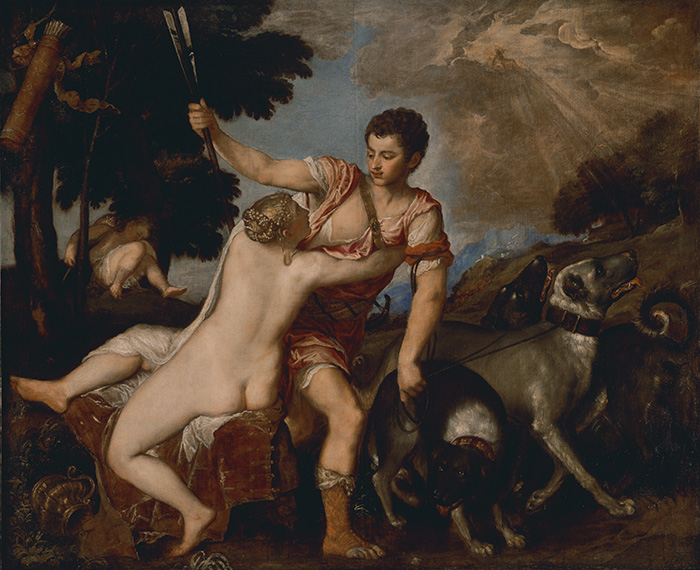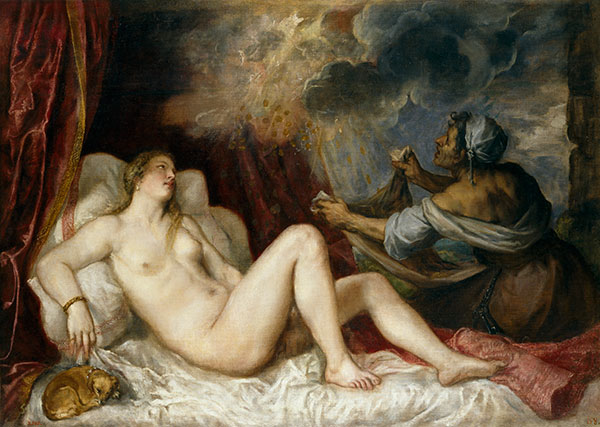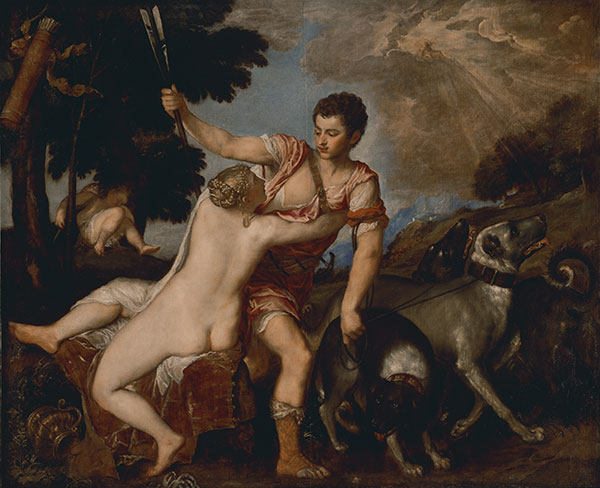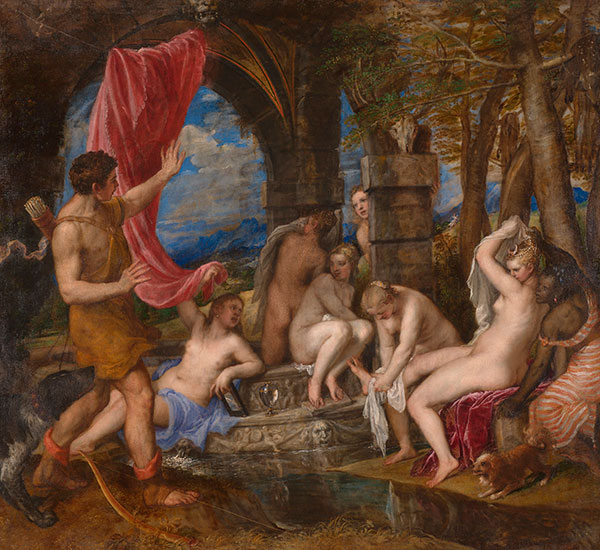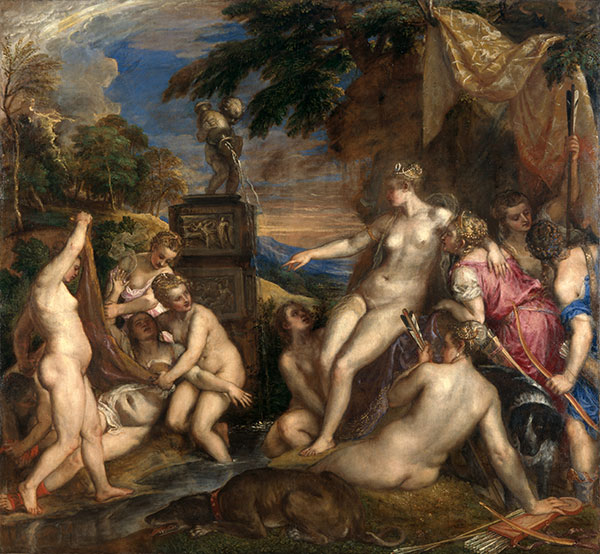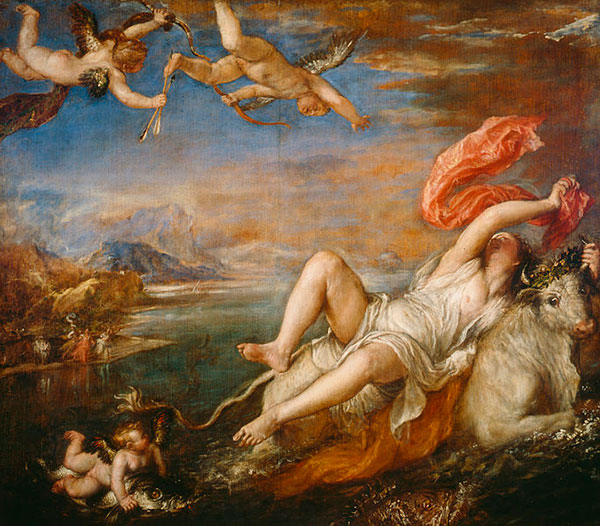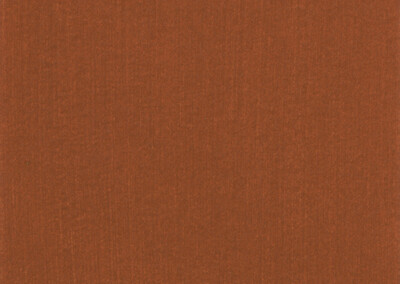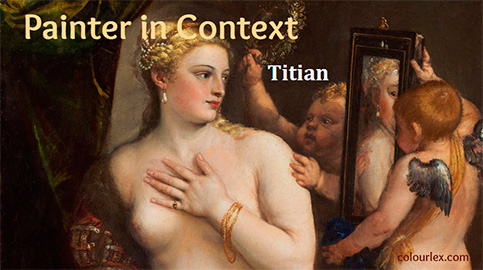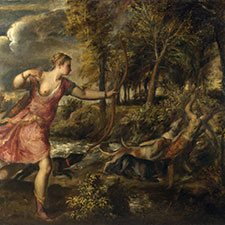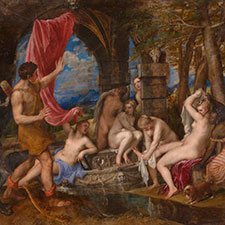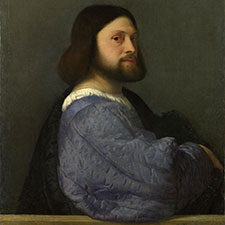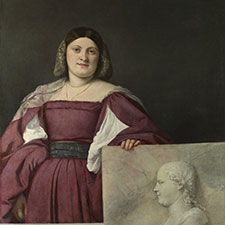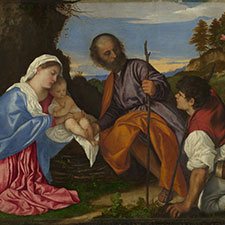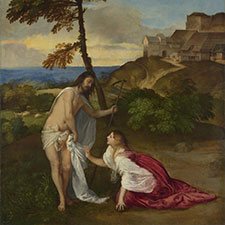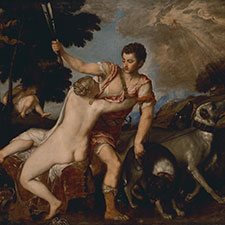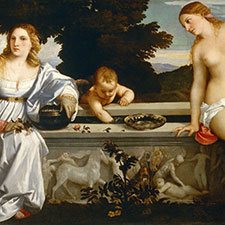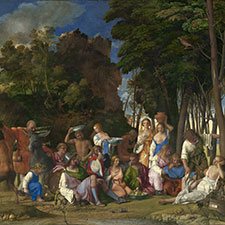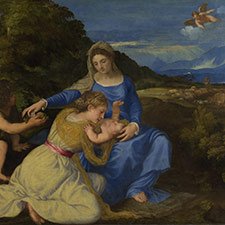Titian, Venus and Adonis
1555-60Titian, Venus and Adonis
1555-60Paintings sorted by Historical period | Painter | Subject matter | Pigments used
Related Paintings: Titian's Poesie Paintings
Titian painted a series of paintings with mythological subjects for King Philip II of Spain. Inspired by Ovid’s Metamorphoses, they are among Titian’s most admired works (1 and 2).
Quote from the website of DeYoung Museum San Francisco
“Titian and the Poesie
Among Titian’s most breathtaking works is a series of mythological subjects known as the poesie, which celebrate the loves of
ancient gods, goddesses, and mortals. In paintings of deep, sonorous color and broken, expressive brushwork, Titian created a visual
equivalent to lyric and emotive forms of poetry. The erotic beauty of the nude female form, often encompassed in the thick atmosphere of a pastoral landscape, is the focus of these compositions. Titian’s classical literary sources, especially the Metamorphoses, completed by the Roman author Ovid around AD 8, provide a veneer of respectability for these remarkable paintings. Ultimately, however, Titian’s poesie explore a world of physical sensuality that is made palpable through his brilliant technique. Designed for the pleasure of the male viewer, paintings such as Danaë were sought after by collectors and often replicated by the artist to satisfy the requests of noble patrons.”
The Poesie paintings
Danaë with a Nurse or Danaë Receiving the Golden Rain, 1553-54, Museo del Prado, Madrid
Danaë, ca 1554, The State Hermitage Museum, St Petersburg, Russia
Danaë with Eros, 1544, Museo e Real Bosco di Capodimonte, Naples. Italy
Titian, Danaë with Nursemaid or Danaë Receiving the Golden Rain, 1560s. Museo del Prado
Venus and Adonis, 1554, The J. Paul Getty Museum
Venus and Adonis, 1554, Museo del Prado
Venus and Adonis, ca 1560, Galleria Nazionale d’Arte Antica, Rome
Venus and Adonis, ca 1560, National Gallery of Art Washington
Venus and Adonis, ca 1554, National Gallery London
Titian, Venus and Adonis, 1555-60, The J. Paul Getty Museum, Los Angeles
Diana and Actaeon, 1556-59, National Gallery London and National Galleries of Scotland
Titian, Diana and Actaeon, 1556-59, National Gallery London
Diana and Callisto, 1556-59, National Gallery London
Titian, Diana and Callisto, 1556-59, National Gallery London
Rape of Europa, 1559-62, Isabella Stewart Gardner Museum, Boston
Titian, Rape of Europa, 1559-62, Isabella Stewart Gardner Museum, Boston
Death of Actaeon, 1562, National Gallery London
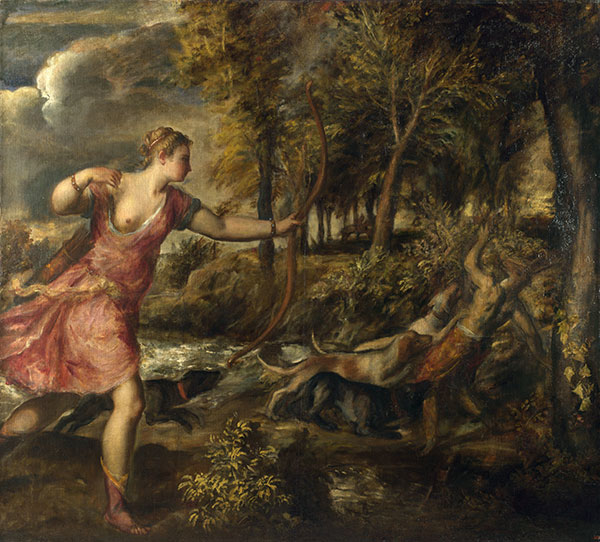
Titian, Death of Actaeon, 1562, National Gallery London
Titian, Perseus and Andromeda, 1554-56, Wallace Collection London
Titian, Tarquin and Lucretia, 1568-71, Fitzwilliam Museum, Cambridge
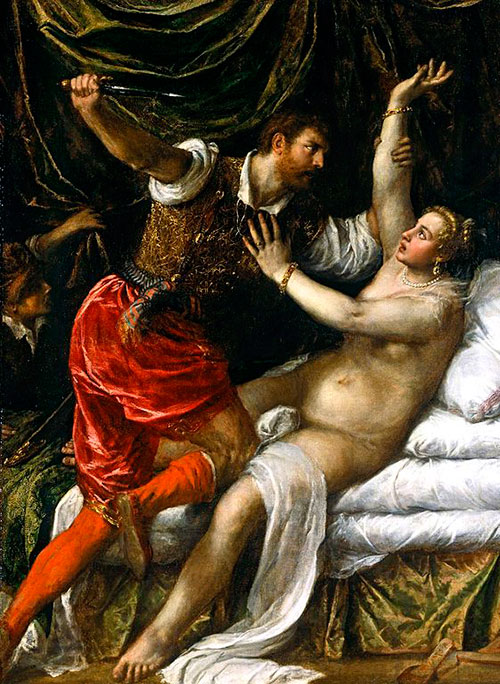
Titian, Tarquin and Lucretia, 1568-71, Fitzwilliam Museum, Cambridge
References
(1) Tanner, M, Sublime Truth and the Senses: Titian’s Poesi (Studies in Medieval and Early Renaissance Art History), Brepols N.V., 2019
(2) National Gallery London, Titian’s ‘poesie’ paintings. [Accessed 30 Jul. 2017].
The Story of Venus and Adonis
The short version of the story given on the website of the J. Paul Getty Museum
“The goddess Venus tries to restrain her lover Adonis from going off to the hunt. She clings to him, imploring him not to go, but Adonis looks down at her impassively. His dogs strain at their leashes, echoing his impatience, as detailed in the tragic love story found in Ovid’s Metamorphoses. Cupid sleeps in the background, a symbol of Adonis’s resistance to Venus’s entreaties, since his ineffective arrows hang uselessly in a tree. The story ends tragically; during the hunt the mortal Adonis is fatally gored by a wild boar.”
The original text by Ovid in English translation
Ovid, Metamorphoses, Book 10, Translated by Sir Samuel Garth, John Dryden, et al. The Internet Classics Archive
Note: Aphrodite, the Greek godess of love, beauty and desire corresponds to the Roman godess Venus. She was sometimes called Cytherea as she was allegedly born on the island of Cythera.
The Story of Venus and Adonis
For Cytherea’s lips while Cupid prest,
He with a heedless arrow raz’d her breast,
The Goddess felt it, and with fury stung,
The wanton mischief from her bosom flung:
Yet thought at first the danger slight, but found
The dart too faithful, and too deep the wound.
Fir’d with a mortal beauty, she disdains
To haunt th’ Idalian mount, or Phrygian plains.
She seeks not Cnidos, nor her Paphian shrines,
Nor Amathus, that teems with brazen mines:
Ev’n Heav’n itself with all its sweets unsought,
Adonis far a sweeter Heav’n is thought.
On him she hangs, and fonds with ev’ry art,
And never, never knows from him to part.
She, whose soft limbs had only been display’d
On rosie beds beneath the myrtle shade,
Whose pleasing care was to improve each grace,
And add more charms to an unrival’d face,
Now buskin’d, like the virgin huntress, goes
Thro’ woods, and pathless wilds, and mountain-snows
With her own tuneful voice she joys to cheer
The panting hounds, that chace the flying deer.
She runs the labyrinth of fearful hares,
But fearless beasts, and dang’rous prey forbears,
Hunts not the grinning wolf, or foamy boar,
And trembles at the lion’s hungry roar.
Thee too, Adonis, with a lover’s care
She warns, if warn’d thou wou’dst avoid the snare,
To furious animals advance not nigh,
Fly those that follow, follow those that fly;
‘Tis chance alone must the survivors save,
Whene’er brave spirits will attempt the brave.
O! lovely youth! in harmless sports delight;
Provoke not beasts, which, arm’d by Nature, fight.
For me, if not thy self, vouchsafe to fear;
Let not thy thirst of glory cost me dear.
Boars know not bow to spare a blooming age;
No sparkling eyes can sooth the lion’s rage.
Not all thy charms a savage breast can move,
Which have so deeply touch’d the queen of love.
When bristled boars from beaten thickets spring,
In grinded tusks a thunderbolt they bring.
The daring hunters lions rouz’d devour,
Vast is their fury, and as vast their pow’r:
Curst be their tawny race! If thou would’st hear
What kindled thus my hate, then lend an ear:
The wond’rous tale I will to thee unfold,
How the fell monsters rose from crimes of old.
But by long toils I faint: see! wide-display’d,
A grateful poplar courts us with a shade.
The grassy turf, beneath, so verdant shows,
We may secure delightfully repose.
With her Adonis here be Venus blest;
And swift at once the grass and him she prest.
Then sweetly smiling, with a raptur’d mind,
On his lov’d bosom she her head reclin’d,
And thus began; but mindful still of bliss,
Seal’d the soft accents with a softer kiss.
Overview
Medium: Oil
Support: Canvas
Size: 160 × 196.5 cm
Art period: High Renaissance
The J. Paul Getty Museum
Painting
Provenance: Venus and Adonis (Getty)
Mappingpaintings.org
Pigments
Pigment Analysis
The following pigment analysis is based on the work of scientists at the J. Paul Getty Museum and the National Gallery of Art (1).
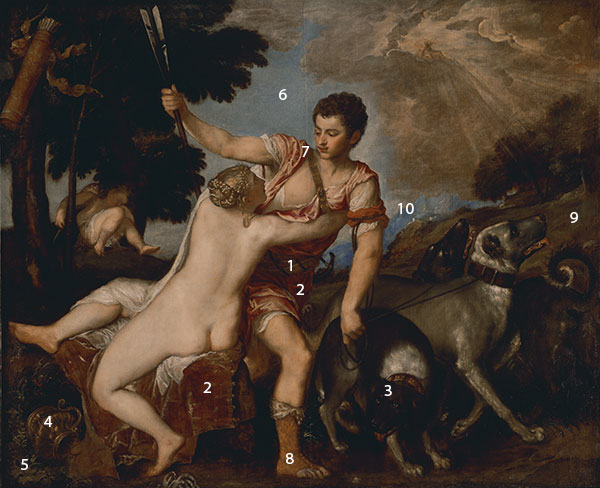
1 Highlights of Adonis’s belt: orpiment.
2 Red tunic of Adonis and red cloth draped over Venus’s seat: so-called lacca de cimatura de grana – red pigment extracted from clippings (cimature) of a red textile containing colorants found both in madder lake and also in carmine (kermes or cochineal).

3 Brown colour of the dogs: brown ochre.
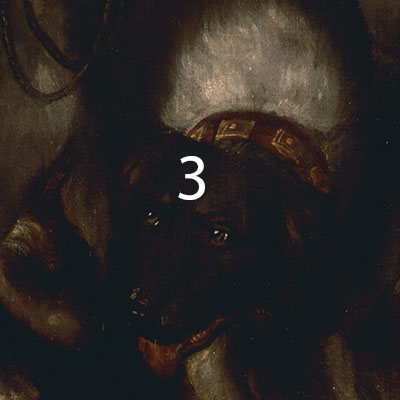
4 Golden vase: yellow ochre.
5 Meadow near the golden vase: copper resinate and yellow ochre.
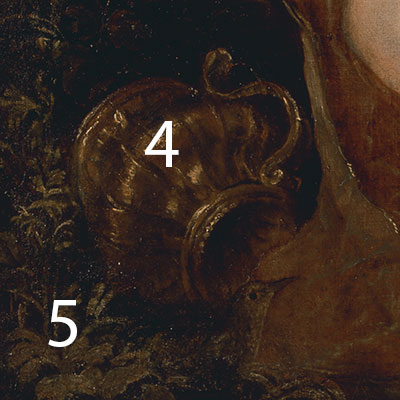
6 Pale blue sky: natural ultramarine, smalt, and lead white.
7 Adonis’s red sleeve: vermilion.
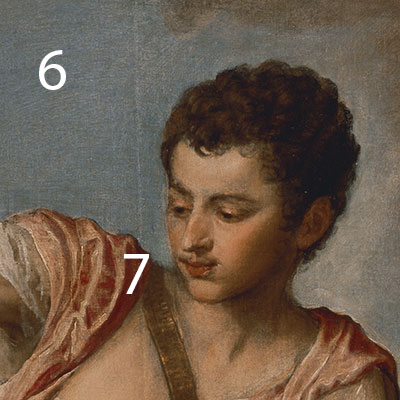
8 Adonis’s shoe: realgar.

9 Green meadow: verdigris.

10 Blue mountain: natural ultramarine.
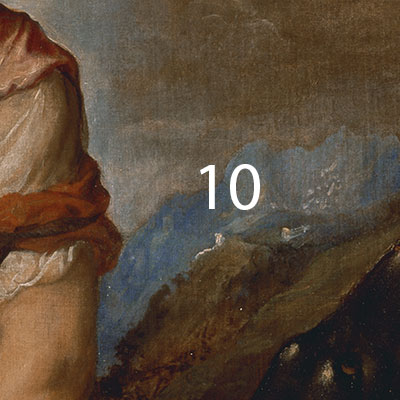
References
(1) Birkmaier, U., A. Wallert, and A. Rothe. “Technical Examinations of Titian’s ‘Venus and Adonis’: A Note on Early Italian Oil Painting Technique.” In Historical Painting Techniques, Materials, and Studio Practice. A. Wallert, ed. (Los Angeles: GCI, 1995) pp. 117-26, fig. 5, pl. 26. Available as pdf.
Pigments Used in This Painting
Resources
See the collection of online and offline resources such as books, articles, videos, and websites on Titian in the section ‘Resources on Painters‘
PowerPoint Presentations
Painter in Context: Titian
A richly illustrated presentation on the Venetian Renaissance painter Titian (Tiziano Vecellio) containing information on painting technique, pigments employed, and important written and online resources.
Number of slides: 23
Formats included in the download: PowerPoint Screen Presentation (ppsx) and pdf
Videos
Video: Titian, Venus and Adonis: The Myth Behind the Painting'
Video: 'Titian: Love, Desire, Death, by National Gallery London
Publications and Websites
Publications
(1) Sutherland, Bruce D. “A Subtle Allusion in Titian’s ‘Venus and Adonis’ Paintings.” Venezia Cinquecento. Studi di storia dell’arte e della cultura 9, no. 17 (January-June 1999) pp. 37, 40, 46, fig. 2.
(2) Birkmaier, U., A. Wallert, and A. Rothe. “Technical Examinations of Titian’s ‘Venus and Adonis’: A Note on Early Italian Oil Painting Technique.” In Historical Painting Techniques, Materials, and Studio Practice. A. Wallert, ed. (Los Angeles: GCI, 1995) pp. 117-26, fig. 5, pl. 26. Available as pdf.
(3) Tanner, M, Sublime Truth and the Senses: Titian’s Poesi (Studies in Medieval and Early Renaissance Art History), Brepols N.V., 2019

